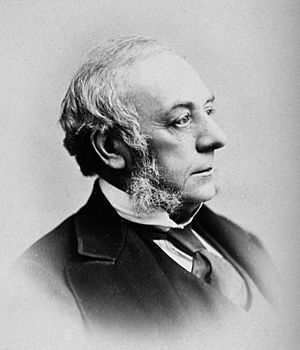John Eric Erichsen facts for kids
Quick facts for kids
Sir
John Eric Erichsen
1st Baronet, MRCS FRS
|
|
|---|---|
 |
|
| Born | 19 July 1818 Copenhagen, Denmark
|
| Died | September 23, 1896 (aged 78) Folkestone, Kent, England
|
| Resting place | Hamstead Cemetery |
| Nationality | British |
| Education | Mansion house school, Hammersmith University college hospital medical school |
| Occupation | Surgeon |
| Known for | Surgical skills, particularly following railway accidents |
|
Notable work
|
The science and the art of surgery, 1st edition 1853 |
| Spouse(s) | Mary Elizabeth |
| Honours | President of the council of University College |
Sir John Eric Erichsen (born July 19, 1818 – died September 23, 1896) was a very important surgeon. He was born in Denmark but became a famous British doctor. He helped shape modern surgery and was known for his amazing surgical skills.
Contents
Early Life of a Surgeon
John Eric Erichsen was born in Copenhagen, Denmark. His father, Eric Erichsen, came from a well-known Danish banking family. John went to school at Mansion House School in Hammersmith, England.
Becoming a Surgeon
Erichsen started his medical studies at University College, London. He learned from a famous surgeon named Robert Liston. Later, he traveled to Paris to learn even more. There, he saw his first colotomy, which is a type of surgery on the colon. After his studies, he returned to London to work as a house surgeon.
Early Career and Teaching
In his early career, Erichsen focused on physiology, which is the study of how living things work. He also taught about anatomy (the study of body parts) at University College Hospital. His lectures and teaching style were very popular.
In 1845, he won a special gold medal for his essay on asphyxia, which is when someone can't breathe. This showed how smart he was.
Rising Through the Ranks
In 1848, Erichsen became an assistant surgeon at University College Hospital. By 1850, he was a full surgeon and a professor of surgery. This was a big achievement! In 1875, he joined the hospital's consulting staff.
In 1876, he was elected a Fellow of the Royal Society. This is a very high honor for scientists. By 1887, he became the president of the council of University College.
Famous Surgical Book
Erichsen wrote a very important book called Science and Art of Surgery in 1853. This book was used by many doctors and went through many new versions. Later versions of his book included new ideas from other famous doctors. These ideas included Joseph Lister's antiseptic techniques and Louis Pasteur's germ theory. These new ideas helped make surgery much safer.
Important Roles and Honors
Erichsen became the president of the Royal College of Surgeons of England in 1880. He was also president of the Royal Medical and Chirurgical Society from 1879 to 1881.
In 1895, he was given the title of a baronet. This meant he could be called "Sir John Eric Erichsen." For many years, he was also a special surgeon to Queen Victoria.
Expert on Injuries
Erichsen was known around the world for his surgical skills. He was especially an expert on injuries to the spine, especially those from railway accidents. He was often asked to speak in court about these types of cases.
A Misunderstood Quote
There is a famous quote that people often say Erichsen said in 1873. The quote suggests that surgeons would never be able to operate on parts of the body like the abdomen, chest, or brain.
However, this quote is not exactly what he said. What he actually said was that there would always be limits to surgery. He believed that some parts of the human body would remain "sacred" from the surgeon's knife.
Later, someone writing about another surgeon, Joseph Lister, wrote that Erichsen believed the abdomen, brain, and chest would be "forever shut" from surgery. People then mistakenly thought Erichsen himself said those exact words. But if you read his full speech, he actually talked about successful surgeries on many parts of the body, from the brain to the pelvis. This shows his views were more complex than the simple quote suggests.
Personal Life
John Eric Erichsen married Mary Elizabeth on September 10, 1842. She was the oldest daughter of Captain Thomas Cole. Sadly, she passed away in 1893, and they did not have children.
People described Erichsen as an "honorable and candid" person. He was also known for being a true gentleman and for supporting his younger surgeons.
Erichsen passed away in Folkestone in 1896. He was buried in Hampstead Cemetery.
Images for kids


